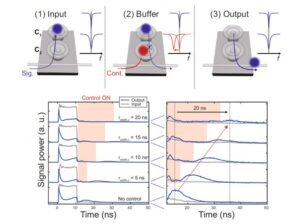Photonic crystal EO modulator fabricated by CMOS compatible process
Research
Photonic crystal EO modulator fabricated by CMOS compatible process
Integration of electro-optical modulators on a silicon chip using photonic crystals
Power consumption in data centers is increasing dramatically, and it is expected that optical transmission over medium to short distances will significantly reduce power consumption. However, to achieve this, it is necessary to develop elements that convert the electrical signals used in signal processing into optical signals for transmission, and it is necessary to realize compact and power-efficient electro-optical modulators. Since electrical processing is realized in CMOS circuits on a silicon chip, ideally, optical elements made of silicon that can be integrated into CMOS circuits are required, and we have been working on this issue.
In this study, we have successfully developed a device that converts electrical signals into optical signals by integrating a pin diode structure into a photonic crystal resonator using a CMOS compatible fabrication method.

Although similar devices have been reported in the past, they were conventionally fabricated by a method called electron beam lithography, which is not suitable for future mass production and integration with CMOS devices. We have fabricated high-performance photonic crystal resonators by photolithography, a CMOS-compatible technique, and integrated pin structures. The all-silicon structure is inexpensive and has excellent characteristics as an optical modulator.
- Categories
- 研究トピックス



